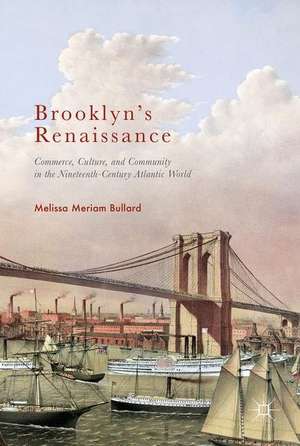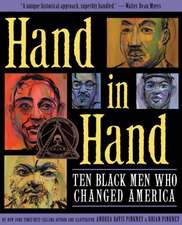Brooklyn’s Renaissance: Commerce, Culture, and Community in the Nineteenth-Century Atlantic World
Autor Melissa Meriam Bullarden Limba Engleză Hardback – 13 iun 2017
| Toate formatele și edițiile | Preț | Express |
|---|---|---|
| Paperback (1) | 589.14 lei 6-8 săpt. | |
| Springer International Publishing – 13 mai 2018 | 589.14 lei 6-8 săpt. | |
| Hardback (1) | 658.37 lei 6-8 săpt. | |
| Springer International Publishing – 13 iun 2017 | 658.37 lei 6-8 săpt. |
Preț: 658.37 lei
Preț vechi: 774.55 lei
-15% Nou
Puncte Express: 988
Preț estimativ în valută:
125.98€ • 131.88$ • 104.24£
125.98€ • 131.88$ • 104.24£
Carte tipărită la comandă
Livrare economică 05-19 aprilie
Preluare comenzi: 021 569.72.76
Specificații
ISBN-13: 9783319501758
ISBN-10: 3319501755
Pagini: 284
Ilustrații: XVI, 458 p. 16 illus. in color.
Dimensiuni: 148 x 210 mm
Greutate: 0.92 kg
Ediția:1st ed. 2017
Editura: Springer International Publishing
Colecția Palgrave Macmillan
Locul publicării:Cham, Switzerland
ISBN-10: 3319501755
Pagini: 284
Ilustrații: XVI, 458 p. 16 illus. in color.
Dimensiuni: 148 x 210 mm
Greutate: 0.92 kg
Ediția:1st ed. 2017
Editura: Springer International Publishing
Colecția Palgrave Macmillan
Locul publicării:Cham, Switzerland
Cuprins
Chapter 1: Introduction.- Chapter 2: Parallel Renaissances in the Atlantic World.- Chapter 3: Black Ball Business and Commercial Networks.- Chapter 4: First Steps Towards Brooklyn’s Renaissance.- Chapter 5: Symphony of the Arts.- Chapter 6: Sociability, Civil War and a Diverted Renaissance.- Chapter 7: Culture of War Relief.- Chapter 8: Brooklyn’s Changing Complexion.- Chapter 9: Impact on the Arts.- Chapter 10: A Fading Renaissance.- Appendix: Brooklyn’s Principal Patrons.
Notă biografică
Melissa Meriam Bullard is Professor of Renaissance and Early Modern European History at the University of North Carolina at Chapel Hill, USA. She has published extensively on the history of the Medici and Florence and recently on the reach of the Italian Renaissance into the nineteenth-century. She brings an Atlantic world perspective of parallel Renaissances to Brooklyn’s history.
Textul de pe ultima copertă
This book shows how modern Brooklyn’s proud urban identity as an arts-friendly community originated in the mid nineteenth century. Before and after the Civil War, Brooklyn’s elite, many engaged in Atlantic trade, established more than a dozen cultural societies, including the Philharmonic Society, Academy of Music, and Art Association. The associative ethos behind Brooklyn’s fine arts flowering built upon commercial networks that joined commerce, culture, and community. This innovative, carefully researched and documented history employs the concept of parallel Renaissances. It shows influences from Renaissance Italy and Liverpool, then connected to New York through regular packet service like the Black Ball Line that ferried people, ideas, and cargo across the Atlantic. Civil War disrupted Brooklyn’s Renaissance. The city directed energies towards war relief efforts and the women’s Sanitary Fair. The Gilded Age saw Brooklyn’s Renaissance energies diluted by financial and political corruption, planning the Brooklyn Bridge and consolidation with New York City in 1898.
Caracteristici
Provides an outstanding cultural analysis of Brooklyn's development in the context of the Renaissance in Europe Appeals to scholars of European and American cultural history as well as those interested in Brooklyn more broadly Written by a leading historian of European history using a transatlantic approach to the rise of American urban centres











